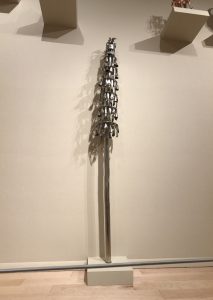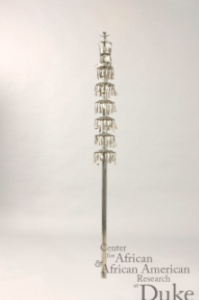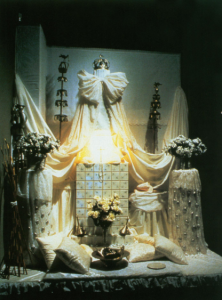The staff (paxorô) for the God Oxalufa is my object of interest for this analysis. The simplicity and complexity of this object were very compelling to my eye. Walking around the museum my eyes and mind stumbled upon a tall staff surrounded by various crowns. Mounted on a block, standing about 5 feet tall stood this particular all silver staff. At the top of the silver staff is a silver crown with a single standing dove upon the crown. Hanging out of the mouth of the dove is a silver pendant of a bell. Pendants fall from the bottom of the crown in symbols of bells, mortars, fish, butterflies, and feathers. Approximately halfway from the top of the staff down to the middle of the staff are 6 equally placed tier-like structures. Starting from the topmost tier slightly under the crown and then going down, each tier progressively gets moderately larger. Identical to the crown mounted at the top of the staff, each of the tiers has the same pendants hanging from them. Each pendant represents an Orixa or God of the Candomblé religion. Visually analyzing this object lead to my curiosity about the use of this object and the symbolism this object provides the individual who uses it in the Candomblé religion. Through research of the God associated with this staff, I was able to figure out the meaning behind this staff.


The religion this objectis associated with is the religion of Candomblé, an Afro-Brazilian religion. Candomblé was founded in the late eighteenth century around Bahia. The elements in Candomblé resemble elements of Yoruba religion. This decent of Candomblé from Yoruba was due to the prominent practice of the Yoruba religion among slaves. Candomblé focuses on the traditional dispensing of sacraments to the orixas or spirits or deities. Specifically, this object is for the orixa Oxalufa also known as Oxalá or Obatala.
The orixa Oxalá is known in the Candomblé religion as the father of all Gods and the creator of mankind. He is known as the high God or the supreme God and is also the seniority figure. This position was gained by his high moral standards and the integrity of his priests and worshipers. Oxalá is visualized as the oldest of the orixas and walks with the staff to support his hunched over body. Seniority, purity, and whiteness are all used to describe him. White clothing is broadly associated with Candomblé but is more specifically worn by Oxalá worshipers. White and silver are known to be Oxalás colors because they are the simplest and purest colors.
This staff is meant to be a symbol of higher power and higher authority. It’s relation to the God Oxalá gives those in the possession of the staff the view that they are a superior and are a follower of Oxalá. The staff is a symbol of power and the mixture of this and the association with the supreme God gives the staff the symbolism of royal power or authority power. The dove at the top of the staff symbolizes that purity of Oxalá. The dove is also the preferred sacrificial animal to give to Oxalá. This purity and power are shown through the staff with its numerous pendants. Each pendant is associated with another orixa or God in the Candomblé religion. For example, the pendant of the fish represents the goddess of the sea Iemanja and the butterfly represents the goddess Iansa. Oxalá is the father or the senior brother to each other orixas. Therefore, their involvement in the staff dedicated to Oxalá symbolizes his authority to all kinds, Gods, and mankind.
In an altar created by Mai Jocelinha in Salvador, Bahia, Brazil, two staffs of Oxalá are placed on either side of a white draped cloth making it look like Oxalá as the center with the crown on his head. In front are white and silver offerings including bells, white flowers, metals and ceramic tiles. This altar is meant to convey Oxalás glory, honesty, and purity. The staffs on either side of the altar are to signify the maturity and wisdom of the eldest Oxalá figures.

The representation of authority and seniority are given off by the staff of Oxala. All figures in possession of this staff are not questioned to have great authority in their community. Usually, these figures are the eldest authority or priests who are in possession of this staff. The pendants that hang from each of the tiers are heard to make the noise associated with Oxala. Metals striking against each other is the sound of Oxala walking with the staff to support him. Staffs are commonly seen as a royalty symbol and in the Candomblé religion, this particular staff is seen similarly as a way to identify a person of higher power.
Staff of Oxala Annotated Bibliography
Beier, U. 1956. Nigeria magazine: Obatala festival, 10-28.
Cahn, Peter S. “Brazil.” In Worldmark Encyclopedia of Religious Practices, 2nd ed., edited by Thomas Riggs, 217-226. Vol. 2, Countries, Afghanistan to Ghana. Farmington Hills, MI: Gale, 2015. Gale Virtual Reference Library
Harding, Rachel E. “Afro-Brazilian Religions.” In Encyclopedia of Religion, 2nd ed., edited by Lindsay Jones, 119-125. Vol. 1. Detroit: Macmillan Reference USA, 2005. Gale Virtual Reference Library
ROCA, ROGER SANSI. “Catholic Saints, African Gods, Black Masks and White Heads: Tracing the History of Some Religious Festivals in Bahia.” Portuguese Studies 21 (2005): 182-200.
Thompson, Robert Farris. “Face of the Gods: The Artists and Their Altars.” African Arts 28, no. 1 (1995): 50-61.